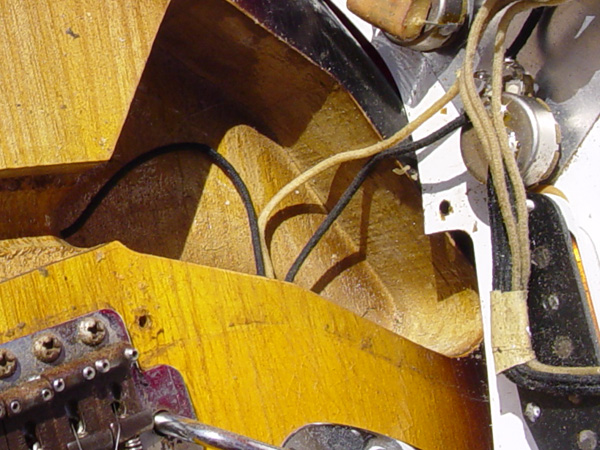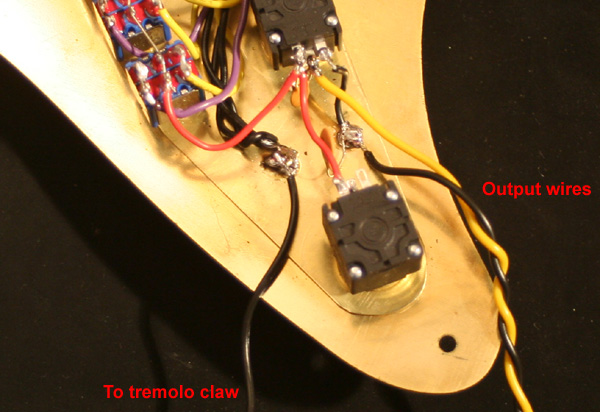For better hum shielding, the strings on electric guitars are normally grounded, which means they are connected internally to the ground of the guitar. For this purpose, usually a ground wire is connected somewhere to the guitar bridge, in the case of a Stratocaster with tremolo this is normally a wire from the case of the volume pot to the ‘claw’ that helds the tremolo springs. As the springs are – like the whole bridge – made of steel, the bridge is grounded via the tremolo springs, and the strings via the bridge.
Many guitarists, even the guitar freaks, are not aware that there are two different ways how this was done on the classic (= vintage) Strat. And I have never seen this issue discussed in any guitar book or website, so let’s cover it with this blog post.
The ‘normal’ way (as it is on most Strats and copies) with a wire from the volume pot to the tremolo claw was not the original way how Fender did it but was introduced about 1964/65. In all the years before, the wire went from the tremolo claw to the ground lug of the output jack! Electrically it does not matter whether it runs to the volume pot or the output jack (except some theoretical arguments that might cause a very small and usually negligible difference) but to build a ‘vintage correct’ Strat (or Schecter Dream Machine) it is of course important to know.
The wire runs (see picture below) from the tremolo claw through a drill hole into the electronics cavity, from where it directly runs through the drill hole to the output jack cavity where it is connected to the jack.

The ground wire on the Schecter Dream Machines and on the mk-guitar.com pickguard replicas
On their Dream Machines, Schecter used the original style that Fender used from 1954 to 1964, the wire from the tremolo claw to the output jack. The pickguard is connected with only two wires, the hot (yellow) and the ground (black) wire. It is a bit different on my replica pickguards which feature the post-1964 style. They come with a third wire, that is soldered to the ground plate of the pickguard (where also the ground wires from the pickups are soldered) and must be connected to the tremolo claw. I did it this non-original way because it is the most common way on a Strat. If I delivered these without this ground wire, you need to connect the existing ground wire from the tremolo claw on your guitar to the output jack. If you have bad luck, the wire will be not long enough to reach the output jack, or the drill hole between the electronics cavity and the output jack is not wide enough for three wires instead of two.

If you build your own Dream Machine and want to do it the vintage-correct style, you can unsolder the ground wire on the replica pickguard (or simply cut it close to the solder point) and run a wire from the tremolo claw to the output jack. I could have shipped the pickguards without this ground wire, and instruct you to solder the one on your guitar yourself to the ground plate of the pickguard but this requires a strong soldering iron as the shielding plate and the whole metal pickguard absorb a lot of heat so that the solder does not flow very well, an effect that is by the way much stronger with the brass or chrome pickguards compared to the white aluminium pickguard.
The original wiring has the advantage that it is a bit more comfortable to work on the electronics of the opened guitar, as only two wires instead of three connect the pickguard to the guitar. One thing however is important NOT to do as this causes a danger of hum due to a ground loop: never use both ground wires (from the pickguard to the tremolo claw + from the tremolo claw to the output jack).

5 thoughts on “Two ways to connect the string ground wire on a Strat”
Question regarding “never use both ground wires” and “ground loops”:
I’ve got a powerhouse strat with 2 ground wires : One going to the trem claw, and the other (body ground) that’s just a screw connected to the body (connected under a layer of finish, presumably to some kind of conductive paint).
I’ve just shielded the heck out of everything, but the trem claw ground still isn’t connected to it yet (body ground is). Should I solder the body ground and the trem claw ground together, to create one ground? How can I avoid ground loops here?
Thanks in advance.
Great question, I have ground wire to my body as well. Did you ever get an answer? What did you end up doing?
I’ve used more than one “ground” wire in strats that needed immaculate shielding for pros playing in adverse conditions all over the world. The idea with grounds or more accurately shielding is to keep them all at the same electrical potential. In other words, short wires and terminating them all to a common point, then connecting that common point to the output jack black wire [ground].
I’m fond of saying nothing is in stone. Experiment a bit. Don’t be afraid. You can’t really hurt anything if you’ve botched up this very low voltage wiring. So my advice,…experiment, try different things, and do research. Have fun!
the vintage style of grounding from the tremolo claw to the out put jack is also used on the ’62/’63 frusciante strat model by esp-edwards… i do not know, however, if this is true to all strats made by the same company.